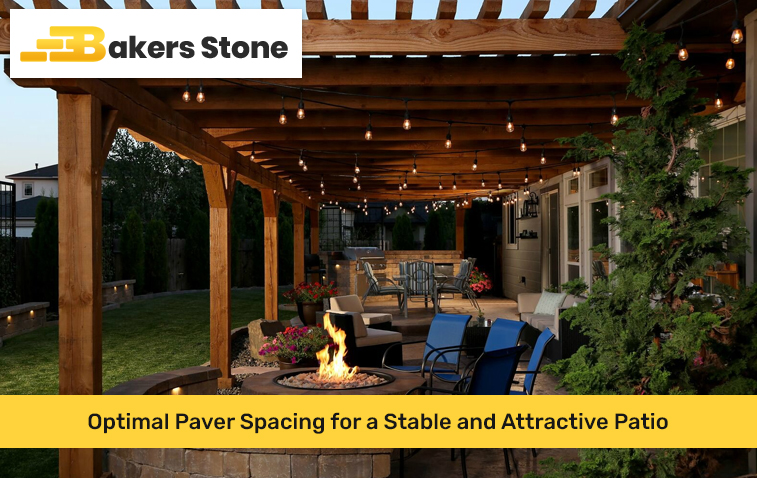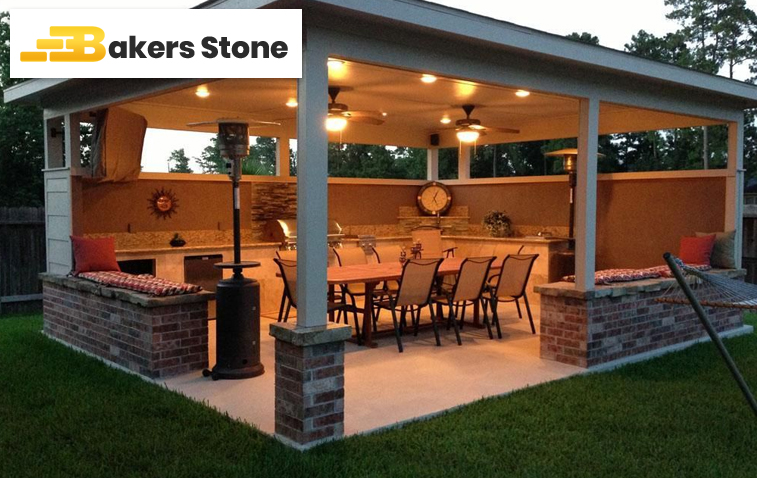Optimal Paver Spacing for a Stable and Attractive Patio
A patio is a wonderful addition to any home, offering a perfect space for outdoor gatherings and relaxation. When designing, optimal paver spacing is crucial. How you space your pavers affects both the stability and appearance of the patio, influencing drainage and preventing water pooling.
On the other hand, if the pavers are too far apart, the patio could become uneven and uncomfortable to walk on. Finding the right balance is crucial for creating a patio that is both beautiful and functional. This guide will explore the importance of optimal paver spacing and provide practical tips to help you achieve a stable and attractive patio.

Why Paver Spacing Matters
Paver spacing might seem like a small detail, but it plays a big role in the overall performance and appearance of your patio. Proper spacing ensures that the pavers stay in place, the patio drains well, and the surface looks neat and tidy.
Stability and Durability
The spacing between pavers directly affects the stability and durability of the patio.
Simple Explanation:
- Even Distribution: Proper spacing helps distribute weight evenly across the patio, preventing the pavers from shifting or sinking over time.
- Interlocking Support: When pavers are spaced correctly, they support each other, creating a strong, interlocked surface that can withstand heavy use.
- Avoiding Movement: Too much space between pavers can cause them to move or become uneven, leading to a bumpy surface that can be unsafe to walk on.
Drainage and Water Management
Good drainage is essential for maintaining the integrity of your patio. Proper paver spacing allows water to drain efficiently, reducing the risk of damage.
Simple Explanation:
- Preventing Pooling: Correct spacing allows water to flow between the pavers and into the ground, preventing puddles from forming on the surface.
- Reducing Erosion: When water drains properly, it reduces the risk of soil erosion underneath the patio, which can cause pavers to shift or sink.
- Maintaining Surface Integrity: By ensuring that water drains away from the patio, you protect the surface from water damage, keeping it looking good for longer.
Aesthetic Appeal
Paver spacing also affects the visual appeal of your patio. The right spacing can enhance the overall look, making it more inviting and stylish.
Simple Explanation:
- Clean Lines: Evenly spaced pavers create clean, straight lines that give the patio a polished and professional appearance.
- Consistency: Consistent spacing ensures that the pattern of the pavers looks uniform, adding to the overall beauty of the design.
- Customization: Different spacing options can create various visual effects, allowing you to customize the look of your patio to suit your personal style.
Optimal Paver Spacing for Different Types of Pavers
Different types of pavers require different spacing to achieve the best results. The material, shape, and size of the pavers all play a role in determining the optimal spacing.
Concrete Pavers
Concrete pavers are a popular choice for patios because they are durable and come in various shapes and sizes.
Simple Explanation:
- Typical Spacing: For concrete pavers, a spacing of about 1/8 inch to 1/4 inch is recommended. This allows for proper drainage while keeping the pavers close enough to support each other.
- Consider Expansion: Concrete can expand and contract with changes in temperature, so it’s important to leave a little extra space to accommodate this movement.
- Grout or Sand: The gaps between concrete pavers can be filled with sand or grout, depending on the look you want and the level of stability you need.
Natural Stone Pavers
Natural stone pavers, such as flagstone or slate, add a rustic and elegant touch to any patio.
Simple Explanation:
- Irregular Shapes: Natural stone pavers often have irregular shapes, so the spacing can vary more than with other types of pavers. Typically, a spacing of 1/4 inch to 1/2 inch works well.
- Custom Fit: Because of their irregular shapes, natural stone pavers may require more customization during installation, adjusting the spacing to ensure a snug fit.
- Natural Look: Larger gaps between natural stone pavers can be filled with gravel, sand, or ground cover plants, enhancing the natural look of the patio.
Brick Pavers
Brick pavers are a classic option that offers a traditional and timeless look for patios.
Simple Explanation:
- Tight Fit: Brick pavers are often installed with tight spacing, usually around 1/16 inch to 1/8 inch. This creates a solid, interlocked surface that’s strong and durable.
- Mortar or Sand: The gaps between brick pavers can be filled with mortar or sand, depending on whether you want a more rigid or flexible surface.
- Uniform Appearance: Tight spacing with brick pavers creates a uniform and consistent appearance, adding to the classic appeal of the patio.
Permeable Pavers
Permeable pavers are designed to allow water to flow through the surface and into the ground, making them an eco-friendly option.
Simple Explanation:
- Wider Gaps: Permeable pavers require wider spacing, typically around 1/4 inch to 3/8 inch, to allow water to pass through.
- Gravel Fill: The gaps between permeable pavers are often filled with gravel or small stones, which help with drainage and add to the overall look.
- Sustainable Choice: The wider spacing and gravel fill of permeable pavers not only improve drainage but also support environmental sustainability by reducing water runoff.
Tips for Achieving Optimal Paver Spacing
Achieving the right paver spacing requires careful planning and attention to detail. Here are some tips to help you get the best results for your patio.
Planning Your Layout
Before you start laying pavers, it’s important to plan the layout and spacing to ensure a smooth installation process.
Simple Explanation:
- Measure Twice: Measure the area where you plan to install the pavers and calculate the number of pavers you’ll need, taking spacing into account.
- Create a Guide: Use string lines or a chalk outline to mark the area and guide your spacing during installation. This helps keep everything straight and even.
- Dry Fit: Lay out the pavers without any adhesive or sand to see how they fit and adjust the spacing as needed before final installation.
Maintaining Consistent Spacing
Consistency is key to a stable and attractive patio. Here’s how to maintain even spacing throughout the project.
Simple Explanation:
- Spacers: Use spacers to ensure consistent gaps between the pavers. These small plastic pieces can be placed between the pavers to keep them evenly spaced.
- Check Your Work: As you lay the pavers, step back and check your work regularly to ensure the spacing is even. Adjust as needed to maintain a uniform appearance.
- Level the Pavers: Make sure each paver is level with the others to avoid uneven surfaces. Use a level tool to check as you go, and adjust the base material if necessary.
Filling the Gaps
After the pavers are laid, filling the gaps is an important step to ensure stability and enhance the look of the patio.
Simple Explanation:
- Sand or Grout: Depending on the type of pavers, fill the gaps with sand or grout. Use a broom to sweep the material into the gaps, and then compact it to ensure a tight fit.
- Watering: Lightly water the surface to help the sand or grout settle into the gaps. You may need to add more material after the initial watering as it settles further.
- Seal the Surface: Consider sealing the pavers and the gaps to protect them from water damage and stains. This can also help keep the gaps filled and prevent the pavers from shifting.
Dealing with Uneven Ground
If your patio area has uneven ground, achieving optimal paver spacing becomes crucial to ensure the pavers are correctly spaced and remain stable.
Simple Explanation:
- Level the Base: Before laying the pavers, make sure the base is level. Use a tamper or plate compactor to smooth the ground and create a solid foundation.
- Adjust Spacing: On uneven ground, you may need to adjust the spacing slightly to accommodate any variations in the surface. Focus on maintaining a stable and level surface.
- Support for Pavers: In areas where the ground slopes, use additional base material to support the pavers and keep them level. This helps prevent them from shifting or becoming uneven over time.

Common Mistakes to Avoid
When installing a patio, there are some common mistakes that can affect the stability and appearance of the final result. Avoiding these mistakes will help ensure a successful project.
Inconsistent Spacing
Inconsistent spacing can lead to an uneven surface and a less attractive appearance.
Simple Explanation:
- Stay Consistent: Use spacers and guides to keep the spacing even throughout the project. Check your work regularly to catch any inconsistencies before they become a problem.
- Measure Carefully: Take the time to measure and plan the layout carefully to avoid misalignment and uneven gaps between the pavers.
Ignoring Drainage
Ignoring drainage can lead to water pooling on the surface, causing damage to the patio over time.
Simple Explanation:
- Plan for Water Flow: Make sure the patio is designed with proper drainage in mind. This includes the spacing between pavers and the slope of the surface to direct water away from the patio.
- Use Permeable Pavers: If drainage is a concern, consider using permeable pavers with wider spacing to allow water to pass through and prevent pooling.
Skipping Base Preparation
A poorly prepared base can cause the pavers to shift and settle unevenly, leading to an unstable patio.
Simple Explanation:
- Prepare the Base: Take the time to properly prepare the base by leveling and compacting the ground. This ensures a stable foundation for the pavers.
- Add a Layer: Consider adding a layer of gravel or sand to help with drainage and provide additional support for the pavers.
Optimal paver spacing is essential for creating a patio that is both stable and attractive. By understanding the importance of spacing, choosing the right pavers, and following best practices during installation, you can achieve a beautiful patio that will stand the test of time. Whether you’re working with concrete, natural stone, brick, or permeable pavers, the right spacing will enhance the appearance, functionality, and durability of your outdoor space. With careful planning and attention to detail, you can create a patio that you’ll enjoy for years to come.
FAQs
The correct spacing depends on the type of pavers you’re using. Generally, concrete pavers require about 1/8 inch to 1/4 inch of spacing, while natural stone pavers may need 1/4 inch to 1/2 inch. Check the manufacturer’s recommendations for the best results.
Yes, sand is commonly used to fill gaps between pavers. It helps keep the pavers in place and allows for proper drainage. Make sure to compact the sand well and refill the gaps as needed after settling.
If your pavers start to shift or become uneven, check the base for any issues. You may need to add more base material, re-level the pavers, and adjust the spacing to ensure stability. Regular maintenance can help prevent these issues.
To maintain the appearance of your patio, regularly clean the surface, refill the gaps with sand or grout as needed, and consider sealing the pavers to protect them from water and stains. Inspect the patio periodically to catch and fix any issues early.
